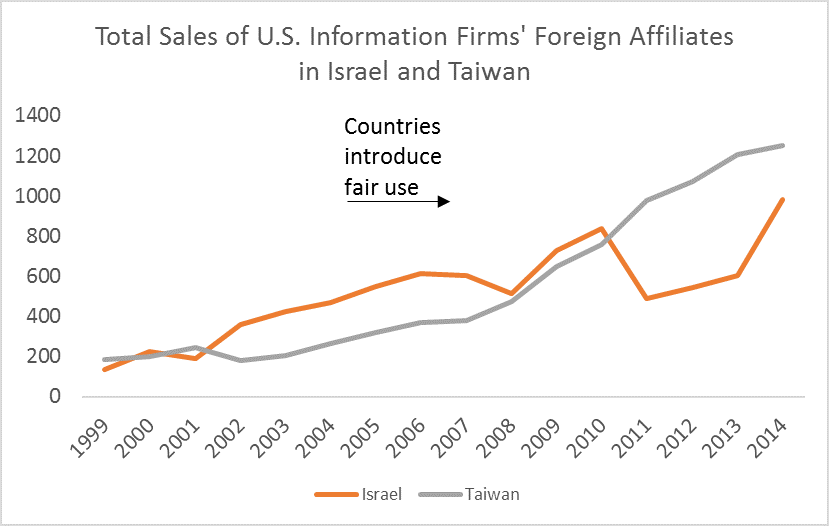 Delivered March 8, 2017 at the Open Hearing that USTR conducted as part of the 2017 Special 301 Review
Delivered March 8, 2017 at the Open Hearing that USTR conducted as part of the 2017 Special 301 Review
Thank you for the opportunity to testify at this hearing. My name is Mike Palmedo, and I work for American University Washington College of Law’s Program on Information Justice and Intellectual Property (PIJIP). We are an academic research program that promotes the public interest in IP policy. Much of my recent research at PIJIP has involved the comparison of copyright limitations in different countries, and the examination of outcomes associated with different copyright limitation structures.
My testimony has four key points:
- U.S. firms that rely on copyright exceptions benefit when foreign nations adopt open, flexible and general exceptions such as fair use
- Copyright industries still earn money from countries that adopt fair use
- The Special 301 Committee should include analysis of copyright limitations when evaluating whether a country provides adequate and effective protection of IP
- The 2017 Special 301 Report should highlight countries that are moving to adopt more flexible copyright practices in its “Best Practices” section
U.S. firms benefit from open, flexible and general copyright limitations in other countries
Intellectual property law in the United States balances the interests of those who own IP and those use it. In the field of copyright, this involves protections against infringement, and when appropriate, limitations allowing unauthorized reproduction and use.
Robust copyright exceptions allow firms in certain sectors like information, research, and communications technology to use works as needed, including certain uses without authorization that do not affect the commercialization of the work. Flexible exceptions such as fair use allow greater innovation with new technologies that move faster than legislative processes.
U.S. firms that rely on copyright limitations have done well when foreign countries have adopted open, flexible copyright limitations in their laws. The most direct example is when countries have adopted fair use exceptions similar to those found here. Between 2006 and 2007, three countries introduced fair use into their copyright laws: Singapore, Israel and Taiwan.
Industry-level data from the BEA shows that foreign affiliates of U.S. information-sector firms in these countries have prospered since they adopted fair use.
The firms in the “Information” sector are those in industries with NAICS codes beginning in 51. This includes high tech industries such as data processing, hosting, and software development, as well as traditional copyright industries such as publishers and motion picture and sound recording industries.
Looking at Total Sales of Foreign Affiliates of U.S. firms in this sector, we see that sales had been growing before the countries adopted fair use. Afterwards, total sales grew slightly faster Singapore and Taiwan, while the rate of growth remained constant in Israel. Affiliate sales in Israel and Taiwan remain a small percentage of worldwide affiliate sales, but Singapore’s share of world affiliate sales rose from 5.7% to 8.2% after fair use. And Singapore has a tiny population of 5.5 million.
Fig. 1A and 1B:
Additionally, the ratio of total sales in this sector from Singapore, Israel and Taiwan to total sales by affiliates based in Europe has increased from 0.09 to 0.16 (with most of the sales in the fair use group coming from Singapore). This indicates that overall growth of affiliate sales in these countries has outpaced overall growth of affiliate sales in countries that do not have fair use.
BEA data on Total Sales from Foreign Affiliates of U.S. firms in the Scientific and Technical Services sector tell a similar story. These are the industries under the two-digit NAICS code 54, and they include research and development services, and computer systems development, among others. Total sales in Singapore, Israel and Taiwan are presented in figure two, below. Sales by foreign affiliates in Singapore and Israel increased significantly after fair use, while sales in Taiwan remained constant. As a percentage of world affiliate sales in this sector, Singaporean affiliates have more than doubled, from 1.2 % to 2.9%.
The ratio of affiliate sales in these three countries to affiliate sales in Europe rose from 0.04 to 0.09 since the introduction of fair use. Once again, this shows that sales in the fair use group are growing faster than sales in the countries with less open copyright exceptions.
Fig. 2
BEA’s industry level data on total assets held by foreign affiliates, and value added by foreign affiliates of U.S. firms in these industries tell a similar story. Since the introduction of fair use in these countries, U.S. parent firms have been building up their affiliates, and the returns are growing. This is true in both an absolute sense, and in relation to affiliate growth in countries with more restrictive laws on copyright exceptions.
U.S. firms still receive payments for use of their IP in these countries.
BEA data does not show a decline in payments for the use of American IP from Singapore, Israel and Taiwan after they introduced fair use. The data, disaggregated in some cases by the type of intellectual property good, show a modest upward trend. Figure three shows data on payments for movies and TV programing from 1999 to 2015. There is an increase after the introduction of fair use in Singapore and Taiwan, and the trend remains flat for Israel.
Fig 3
BEA only has data from 2006 to 2015 for payments for the use of IP in books and music, and it is presented in Figure 4. It shows that there has been an increase in payments from all three of the countries after they adopted fair use.
Fig 4
Requests of the Special 301 Committee
I would like to make two suggestions to the Committee regarding fair use and the Special 301:
- The Special 301 Committee should include analysis of copyright limitations when evaluating whether a country provides adequate and effective protection
The inclusion of strong copyright exceptions as a necessary component to an adequate and effective IP system is consistent with evolving US trade policy. The trade negotiation objectives stated in the Bipartisan Congressional Trade Priorities and Accountability Act of 2015 require negotiators to seek levels of IP that “reflect a standard of protection similar to that found in United States law.” Since USTR has promoted the adoption of flexible copyright limitations elsewhere, including in the TPP, it seems fitting that the Special 301 Committee would include consideration of copyright exceptions in its annual review of intellectual property laws.
- The 2017 Special 301 Report should highlight countries that are moving to adopt more flexible copyright practices in its “Best Practices” section
One place USTR should comment on copyright limitations in foreign country laws is in the Best Practices section of the 2017 Special 301 Report. Trading partners such as Australia, Hong Kong, Nigeria and South Africa (among others) are currently debating whether to implement fair use in their copyright law. Inclusion of fair use as a Best Practice would encourage them to do so, which would benefit U.S. firms and foreign firms alike.
Thank you.









